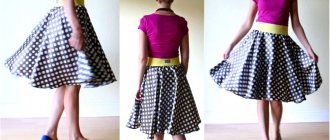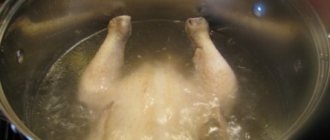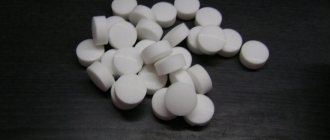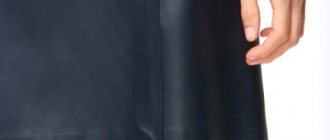Calculation of fabric for a sun skirt
To calculate the required amount of fabric for a sun skirt, first determine whether it will have one seam, two, or no seams at all. Now, starting from the chosen model, we will carry out the calculation.
Seamless
This model is sewn without a seam, so for work you need to take a square. The standard width of the fabric is 140-150 cm, which means we take the same length. In this case, the width of the fabric will dictate the length of the skirt, and not vice versa. Here's what it looks like in practice.
The length of the skirt will be equal to 1/2 the width of the fabric minus the first radius, which is calculated by the formula:
R1 = (From / 6.28)
And minus seam allowances.
From = 70 cm, R1 = 70 /6.28 = 11 cm,
140 cm / 2 = 70 cm, 70 cm - 11 cm = 59 cm, 59 cm - 4 cm = 55 cm
4 cm is seam allowance.
So, with a fabric width of 140 cm and a waist circumference of 70 cm, you can sew a seamless skirt with a length of only 55 cm.
Please note that the fabric is folded in four when cutting.
With two seams
In this case, we will calculate the fabric as for 2 half-sun skirts. We decide on the length and circumference of the waist. We calculate the notch using the formula given in the “No seam” section.
Length - 80 cm, From - 65 cm
R1 - 65 cm /6.28 = 10 cm
Now we choose the fabric. If it is with a print or some kind of floral pattern, then this will oblige you to cut the details in one direction, regardless of the length of the skirt.
In this case, the fabric calculation will be as follows:
The length of the product multiplied by 4, plus 4 notch radii and 4 cm for allowances.
(80 cm x 4) + (10 cm x 4) + 4 cm = 320 cm + 40 cm + 4 cm = 364 cm
If the drawing allows you to make a mirror layout, then the calculation will be slightly different.
We multiply the desired length by 3-3.7, the longer it is, the higher the coefficient we take.
- 80 cm x 3 = 240 cm
- 100 cm x 3.5 = 350 cm - floor-length skirt
To the resulting figure we add four radii and four centimeters for allowances.
- 240 + (10 x 4) + 4 = 284 cm
- 350 + (10 x 4) + 4 = 394 cm
For girl
To calculate the fabric for sewing a skirt for a girl, we determine the length and circumference of the waist.
Example: Length - 40 cm, From - 57 cm, R1 = 9 cm
We count: two skirt lengths plus two R1 and 2 centimeters for allowances.
(40 x 2) + 18 + 2 = 100 cm
This is a fabric calculation with a width of 150 cm and is also suitable for adults if the length of the product does not exceed 60 cm.
Preparing the pattern
The initial stage is the competent construction of the pattern. The final result of the work depends on the accuracy of calculations and correctness of actions. The process should be approached with special care and patience. Despite the fact that the half-sun is one of the simplest styles, if done incorrectly, it is quite easy to ruin the finished version.
Materials
To build a drawing you need to prepare the following:
- sewing meter;
- pencil;
- piece of chalk;
- whatman;
- ruler;
- scissors
- sewing material.
Required measurements
When starting work, first of all take the necessary measurements. For this you will need a sewing meter. We measure the waist circumference, half-hip circumference and the required length . It is recommended to write down the taken indicators. This will help you remember the accuracy of your measurements.
Calculations for patterns
Calculation of small and large radii is the most difficult stage in the entire work process. Let's start counting.
The small radius is calculated using a special formula: K*measurement of waist circumference. Mark K is the coefficient of curvature of the upper cut of the product. For a half-sun skirt it is 0.32 cm.
If the finished product will have an elastic band, you should increase the waist measurements by 1/4, and then make calculations.
To calculate the radius of the bottom, you will need indicators of the length and waist area. The wider the radius, the more voluminous the skirt will be.
Construction of a drawing
Now you can start building the pattern.
- Using a long ruler and a pencil, draw a right angle on whatman paper . We mark the top with a letter (for example, “A”).
- from the top, which is equal to the length of the product . Don't forget to leave 1-2 centimeters for allowance on each side. They are spent on seams.
- The next step is the bottom line . In accordance with the large radius indicators, we make a cone-shaped line, stopping it under the “A” mark.
- Let's move on to the other half of the seam. From point “A” downwards we lay a line identical to the length dimensions.
- The final stage is the small radius - the waist area. From the top of “A” we set aside a measurement that corresponds to the parameters of the waist line radius. Draw an arc connecting both halves.
The pattern is ready.
Help: the increase in waist size can be increased at your own discretion. The more centimeters you add, the more folds you will get on the finished product.
Their depth also depends on the frequency of folds.
After the work has been done on paper, we cut out the pattern and transfer it to the fabric. At the initial stage, it is recommended to build patterns on paper. In the absence of the necessary experience and skills, this will help to significantly save fabric consumption.
Pattern options
- This pattern is suitable for a skirt with one seamless seam . The stitching can be placed on the sides or on the back.
- When creating a pattern for sewing a product with two side seams, similar recommendations should be used. The difference is the process of cutting materials before sewing
. From the top of the right angle, a midline is drawn in the center, which divides the product into two parts. - When creating a pattern for a skirt with a yoke, you can use an example for a straight standard product . Build the skirt itself in accordance with the rules described above.
Tip: if you use a stitch along an oblique line when sewing, you must carefully observe the angle of the center of the parts.
It should be 45 degrees, no more. Otherwise, during use, the skirt may begin to slip and roll to one side.
How much fabric do you need for a semi-sun skirt?
The name half-sun speaks for itself - it is half the sun, which means you will need half as much fabric. In general terms, these are two skirt lengths plus two radii and 4-5 cm allowances. The radius for a half-sun is calculated using a different formula.
R1 = (From / 3.14)
From = 70 cm
R1 = 70 /3.14 = 22 cm
Let's calculate the fabric for the half sun:
- 40 cm long: (40 cm x 2) + (22 cm x 2) + 4 cm = 128 cm;
- 50 cm long: (50 cm x 2) + (22 cm x 2) + 4 cm = 148 cm;
- 60 cm long: (60 cm x 2) + (22 cm x 2) + 4 cm = 168 cm;
- 70 cm long: (70 cm x 2) + (22 cm x 2) + 4 cm = 188 cm.
So it is necessary to calculate either long semi-sun skirts, for example, more than 60 cm long, or for large sizes, where the waist has a significant girth, or for materials with a pattern, when the fabric cannot be laid out in a checkerboard pattern, but only in one line. The half-sun will be cut out with two side seams and with the material fully unfolded. Honestly, this is not the most economical option for one skirt. If it is cut out for a dress, then this is quite acceptable.
In all other cases, the consumption can be reduced, since the length, size and fabric allow you to lay out the patterns so that you can go 1.3-1.5 times the length and radius. The product will also have two seams.
(60+22) x 1.3 = 107 + 4 = 111 cm, where 4 cm is seam allowance
Be sure to take into account the pattern on the material!
Now let’s calculate the material consumption for a half-sun skirt with one seam. This option is suitable for small short skirts and plain fabric that is folded in half.
(70 +22) x 2 = 184 + 2 = 186 cm, where 2 cm is allowance
Video: how to cut a half-sun skirt
Having learned how to cut a skirt in the shape of a semicircle, you can even sew yourself a dress, whole or cut-off. In addition, this form is easy not only to create patterns, but also to sew parts, especially for a one-seam product. If, according to the written instructions, it is difficult to independently make a pattern for a skirt in the shape of half a sun, then watch useful videos that clearly show the whole process.
Half sun pattern
DIY half-sun skirt
Long semi-sun skirt
How to sew a half-sun skirt with elastic
How to calculate the amount of fabric for a double sun skirt
Before calculating the required amount of fabric for a double sun, we first determine the measurements of who it will be sewn on. We take the waist circumference and length of the product, then calculate the radius using the following formula:
R1 = (From / 2) / 6.28
From - 60 cm, R1 = 60 / 2 / 6.28 = 4.7
Product length - 55 cm
For a double sun you need two sun skirts with a recess radius of 5 cm each. For one half you will need fabric:
Two lengths plus two radii and 2 - 3 centimeters for seams:
(55 x 2) + (4.7 x 2) + 3 =122 cm - one half,
122 cm x 2 = 244 cm - into two halves.
When cutting, the material is folded in half. The skirt is more than 60 cm and floor-length and is made from four half-sun skirts.
Features of sewing half-sun
Such skirts gained their popularity back in the 20th century and 30s. American fashionistas imitated the great Coco Chanel. She introduced the pencil and half-sun style into fashion. Every feminine girl of that time had these skirts. In 2000, there was a decline in the popularity of these styles, but since the beginning of 2010, more and more girls began to purchase and sew these skirts themselves. And in 2021, handmade things are gaining popularity.
Conical model
Many girls no longer want store-bought clothes and are trying to do everything not to look like each other. And by the way, making clothes yourself is several times cheaper than purchasing them in various fashion stores, and the quality will be many times higher, because good fabrics are always used when working independently.
It is very difficult to find clothing items that will fit almost all girls and emphasize their advantages. But still, there are some models that suit all body types. This will be a classic half-sun skirt. Its sophisticated silhouette can hide very wide hips or, conversely, balance their absence, can highlight the waistline and even visually enlarge the bust. It is recommended that every girl keep such products in her wardrobe. They go well with both heels and sneakers, sweaters or summer tops.
You might be interested in this Description of all types of seams for hand and machine sewing
Pattern with radius
Due to the fact that the skirt parts are cut at an angle of 45 degrees, they need to be lengthened. This will affect the parts of the back and front half in the middle. If the skirt is made from thin material, then it needs to be lengthened in its finished form. Allowances are required here (no more than 5 centimeters at the hem). Before sewing the parts together, it is advisable to fasten them well.
When creating a product from fabric with a satin weave, you must let the skirt hang for at least a day before straightening the edge. If a lightweight material is selected for the work, then the product can be sewn with an elastic band. At the same time, it can be inserted either along the entire waist line, or separately - two elastic bands along the side seams.
Construction of a drawing
There is no need to make such a skirt from striped materials, as it will be very difficult to match the pattern. Moreover, in this case, fabric consumption will increase. When creating a skirt from satin, you need to consider that it will look different from the front and back. This is due to the bias cut.
Preparing a skirt for fitting
To properly prepare a skirt for fitting, you need to know the proportions of your figure:
- Put the product on the figure, secure the clasp along the waist line in a vertical position with the point of the pin down;
- Look at the side sections, they should be vertical, strictly in the center;
- The folds should also be vertical;
- Check the location of the hem of the skirt;
- View the location of the darts, because they do not have the same location and depend on the volume of the abdomen;
How should the product fit correctly?
- If the stomach is flat, then the darts are located mainly at the side cut in order to add a little volume;
- Check the depth and length; if it needs to be changed, then needles are inserted along the darts at the end, across;
- View the height and width of the yoke along the waist and hips;
- Check the design of the hem; in such skirts, the grain thread runs obliquely or at an angle of 45 degrees and will be stretched, and the hem will be of uneven length. To prevent this from happening, the product needs to hang for a couple of days;
- You can add weight to speed up the process.
You might be interested in: The reasons for missing stitches when sewing with a sewing machine and how to repair them
Tutu model
Now you can try on the product on a person.










